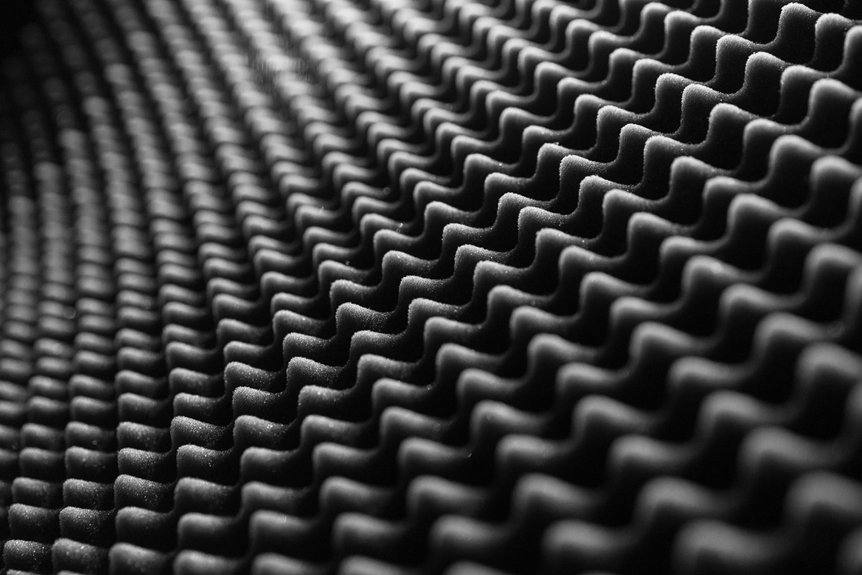3M Thinsulate insulation is a lightweight and high-performance material predominantly crafted from synthetic polyester fibres. It delivers excellent thermal and acoustic insulation, making it ideal for applications such as clothing, vehicles, and building insulation. The fibres are engineered to effectively trap heat while remaining breathable and moisture resistant. Various variants even offer flame resistance or soundproofing properties.
To discover more about this versatile material, continue exploring its features and benefits in detail.
Key Features and Composition
The key features and composition of 3M Thinsulate Insulation revolve around its distinctive material blend and manufacturing techniques.
It’s primarily crafted from incredibly fine synthetic fibres, predominantly polyester, with certain variants incorporating polypropylene or modacrylic. For instance, one type utilises pure polyester fibres, ensuring safety for infants and compliance with stringent safety standards.
Another variant is designed with a combination of modacrylic, aramid, and polyester, which grants it flame resistance. Additionally, some acoustic versions merge polypropylene and polyester to provide effective soundproofing.
The innovative manufacturing process employs Melt Blown Technology, which produces short, thick fibres that effectively trap air. This unique structure ensures that the insulation remains lightweight, compact, and highly breathable, delivering warmth without unnecessary bulk.
Manufacturing processes also play a crucial role in enhancing the durability and performance of Thinsulate insulation, ensuring it maintains its insulating properties over time even under challenging conditions.
There are also environmentally friendly choices available, adhering to both safety and eco-certification standards, making 3M Thinsulate Insulation a versatile option for various applications.
Thermal and Acoustic Performance
3M Thinsulate Insulation is renowned for its exceptional thermal and acoustic performance across a variety of applications. With its impressive thermal resistance, Thinsulate helps maintain comfortable temperatures, keeping spaces warm during colder months and cool in summer. Its low thermal conductivity ensures efficient insulation without adding unnecessary bulk, making it particularly suitable for compact areas. Some Thinsulate products feature advanced materials that enhance insulation capabilities, providing high performance while remaining lightweight and easy to install. Its acoustic properties are equally noteworthy, effectively absorbing sound across a broad frequency range, which significantly reduces noise levels. Thinsulate is widely used in vehicles, appliances, and industrial settings, contributing to improved comfort and safety. The durability of this insulation ensures that it retains its thermal and acoustic qualities over time, offering reliable performance that stands the test of time. High temperature resistance also allows Thinsulate to perform effectively in demanding environments such as engine compartments and electric motors, further expanding its utility.
Diverse Industry Applications
Diverse industry applications highlight the versatility of Thinsulate insulation across various fields.
In the automotive sector, it’s utilised in door panels, wheel arches, and HVAC systems to enhance warmth and reduce noise levels. The garment industry reaps the benefits of its lightweight, moisture-resistant qualities in jackets, gloves, and boots, ensuring that wearers remain warm and comfortable. Thinsulate’s ability to block out external noise effectively contributes to improved comfort and safety in various environments. Excellent absorption of middle- to high-frequency sounds makes it suitable for use in different noise reduction applications. Thinsulate also contributes to energy efficiency in HVAC systems by providing superior thermal regulation. Its insulating properties make it ideal for use in industrial protective gear, offering safety and durability for workers in demanding environments.
In addition, 3M’s Flowable Featherless Insulation, composed of over 85% recycled materials, champions sustainability by minimising waste and lowering carbon emissions.
Across these sectors, Thinsulate seamlessly connects high quality with eco-conscious practices, establishing itself as a trusted choice for manufacturers striving for exceptional performance alongside environmental responsibility.
Installation and Usage Tips
Accurate measurement of each panel or surface is vital for a successful Thinsulate insulation project. Careful assessment ensures that the pieces fit perfectly, eliminating any gaps. Marking panels prior to removal helps to maintain their original positions during reassembly.
To avoid damage, it’s advisable to use push pin pliers or flat-head screwdrivers to gently detach clips and screws. Allowing approximately 1.5 inches of space facilitates easy insertion of the insulation. Planning sections in advance enhances efficiency.
When it comes to cutting, utilise sharp scissors or rolling cutters, making slightly oversized cuts and trimming during test fits. For more intricate shapes, consider cutting slots or strips.
Applying adhesive evenly, such as 3M 90 or P329, ensures a robust bond, particularly for larger pieces. Press the insulation firmly into place, smoothing it around curves, and reattach the panels securely to optimise insulation performance.
Conclusion
3M Thinsulate insulation provides outstanding thermal and acoustic performance due to its unique fabric composition. Its versatile characteristics make it suitable for a wide range of applications, including clothing and automotive sectors.
This insulation is easy to install and highly effective, ensuring reliable performance in various environments. By understanding its key features and appropriate usage, users can maximise its benefits, making it a practical choice for those in search of efficient, lightweight insulation solutions.
Thinsulate is widely regarded as a trusted option for meeting thermal and sound insulation requirements, remaining popular among consumers and professionals alike. Its ability to offer both warmth and noise reduction makes it an excellent choice for improving comfort in homes, vehicles, and beyond.

